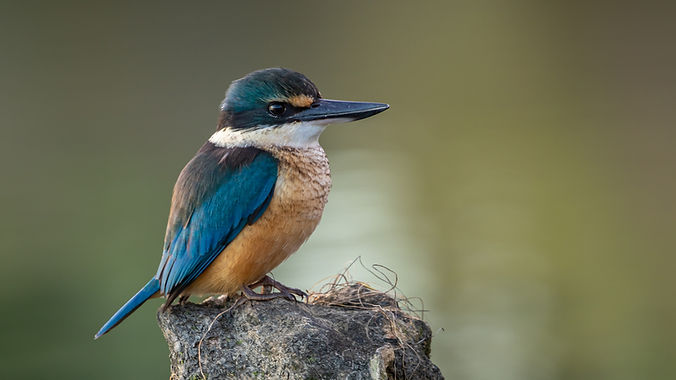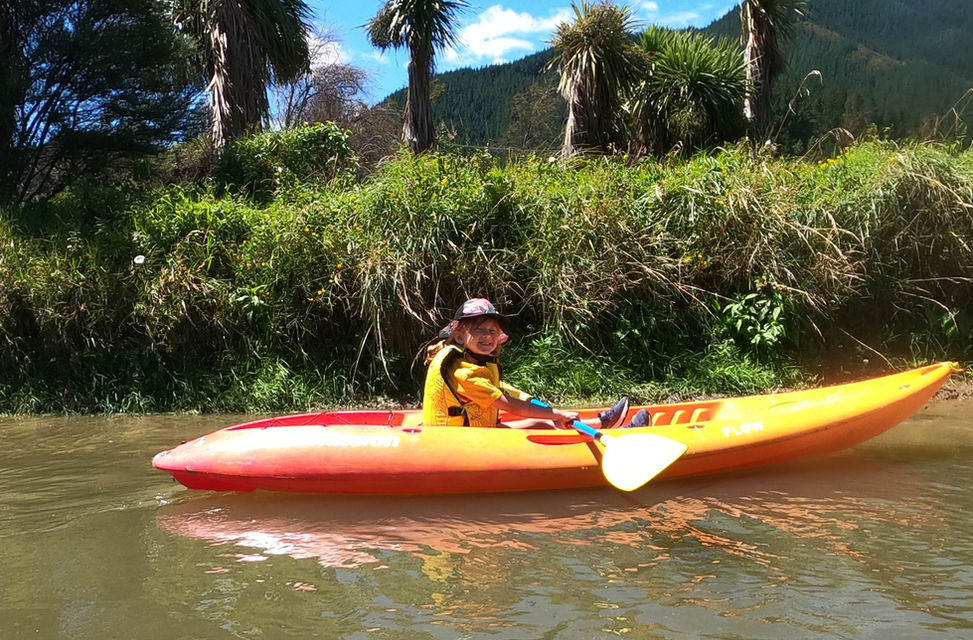
Kōtare ~
Kingfisher
(Alcedinidae)
The Sacred Kingfisher is native to New Zealand.
Found widely across NZ, they are easily identified by their bright blue feathers and unique silhouette of a prominant beak and tail.
Native - Not Threatened

Kōtare
Facts!
General
NZ kōtare grow to about 23cm in length are very easy to spot. They have a distinctive bright green and blue set of feathers on their backs down to their long tail and across their wings. They have a distinctive white band that runs around their necks with a yellow and white chest. Male kōtare are normally much brighter than the females.
You will also notice a kōtare has a larger bill-shaped beak, rather than the slender, more narrow beak often found in other birds.

Image Credit - Marie-Louise Myburgh via NZ birds online
ACTIVITIES, CRAFTS, GAMES AND QUIZIES
Throughout this page you'll find some fun activities and resources you can explore at home with your whānau and friends.
Some of these resources have been put together with the help of our fantastic local organisations.
A huge thank you to those people who have helped put these together for us, we appreciate your support!
Don't forget to share your activities with us, either tag us on social media
or email them to us at conservationkids@envirohub.co.nz


CRAFT - Kōtare Mask

Image Credit - Totaea Art
Birds in general hold a vital place in traditional Maori life, providing food, feathers for adornment. Whakataukī (sayings) and metaphors are often used to compare birds with people’s behaviour (favourably or unfavourably), which is also the case with the kōtare.
Kōtare are admired by Maori for being a watchful sentry. A sentry is person who guards or controls access to a place. Kōtare are admired for the way they perch, without moving, while stalking and waiting for prey... then suddenly attacking in a blur of speed and colour!
A good sentry was complimented by being likened to a kōtare.
The word ‘Kōtare’ was also sometimes referred to as the elevated platform in a pā, used to watch out for enemies.
Kōtare
Facts!
Te Ao
Maori
Kōtare Mask
Have a go at making a kōtare mask over at Wildlife Watch. See if you can recreate the bright, beautiful colours that you can see on a kōtare!

CRAFT - Kōtare Mask

Kōtare
Facts!
Kōtare like to live all over NZ in both coastal and inland freshwater habitats. They live in a wide range of locations including: forest, river margins, farmland, lakes, estuaries and rocky coastlines. Basically, they can be found anywhere where there is water and elevated perches for them to watch from. This is one of the reasons they like wetland areas so much. Although kōtare make nests in a lot of places, one of the neat places they will build a nest for their chicks is in the side of a bank. They dig into clay banks to clear out a hole for their nests. Sometimes, if you are careful, you can lean over the side of a bank and spot a wee kōtare chick popping its head out.
Habitat
Image Credit - Bruce Buckman by Bruce Buckman www.flickr.com/photos/brunonz/
ART - Draw Your Own Kōtare
Draw Your Own Kōtare
Have a go at drawing your own kōtare, take a close look at all the details shape, size and colour. Make sure you share your final drawing with us as we would love to see it!

Kōtare
Facts!
Ecology
& Diet
Their diet when living in estuarine mudflats is mainly small crabs, with a range of tadpoles, freshwater crayfish and small fish in freshwater habitats.
When living in open country they eat insects, spiders, lizards, mice and small birds.

Image Credit - dalous p.
GAMES - Beak Test Game
Grab a few items and have a go at the Beak Test game.
Learn about the diffrent types of beaks and how they .
Beak Test Game
Birds have lots of different beak shapes, have a go at picking up items with some different beak shapes. Can you guess why the kōtare has a larger beak?
If you give this game a go with your class or some friends we would love to hear all about it!

Image Credit - Eugene Polkan via NZ Birds Online
Did you know that you will very rarely see more than two kōtare together? Kōtare are mostly solitary and prefer to hang out by themselves or occasionally in pairs. If you see more than two kōtare together, you can almost guarantee it is breeding season.
Kōtare don't build nests like other birds; they prefer to hollow out areas to nest in. Places like trees, banks or even the side of a cliff are prime real estate for kōtare. The female kōtare repeatedly flies at a site using her bill to create a hole. Once there is enough space to perch on, she continues to hollow out the area with her bill until she has an area large enough to lay her eggs. A female kōtare will lay 4 to 7 eggs at once and she will often have 2 or 3 broods a year!
Kōtare
Facts!
Breeding
ACTIVITY - Test Your Knowledge
Test your knowledge - Species Quiz
Have a go at testing what you have learnt about the kōtare/kingfisher. Click on the image below to download the quiz as a PDF and write in your answers!
Kōtare
Facts!
Crazy Facts!
Have you ever wondered what a kōtare sounds like?
Maybe you have heard them in your backyard but not realized it!
Click this link to go a video of a kōtare call - let us know if you have ever heard one at home. Maybe you could head to a local wetland or area in your backyard where you can try and hear one for your self.
CLICK THE LINK BELOW:

Image Credit - Brian Anderson, BaPhotographic
Other Kōtare/Kingfisher Resources
Below you will find links to other Kōtare / Kingfisher resources, click the images to take you to the websites. Check them out!
The Adventures of Hutu & Kawa
by Avis Acres
Kotare Birds of NZ Activity Pack
by Green Grubs
DOC - Toyota Kiwi Guardian Activity
Have a go at a Garden Bird Survey!
Although the Toyota Kiwi Guardian programme has now finished and you can no longer claim the medals.
The activates are still a fantastic way for your tamariki to help support our conservation and native species.
Below is a link to the "Garden Bird Survey" activity instructions!
Help to find out what species you have in your backyard!!

Image Credit - Antonia O'Donnell
The kōtare faces several threats including cats, possums and even windows. Kōtare, like many other birds, can accidentally fly into glass windows and suffering injuries, being stunned or even sadly breaking their necks. Don't worry, though, there are some simple things you can do to help our beautiful kōtare!
Kōtare
Facts!
Threats
Kōtare
Facts!
What YOU can do!
There are some simple things you can do to help protect our kōtare.
-
If you own a cat, keep it well feed and inside the house at night. Put a bell on its collar to help alert our kōtare, and other birds, to the cat's presence.
-
Kōtare can accidentally fly into windows as they may not realise the window is there as they are clear. You can help make the window stand out by putting reflective stickers on them - you can have fun making some of your own with our instructions below!

Image Credit - Antonia O'Donnell
Visit a Kōtare - Kingfisher
If you want to try and spot a kōtare in your own region, head to any local wetland, lagoon or coastal area to see if you can spot them. Better yet, keep your eyes peeled, even in your own neighbourhood, up trees and on powerlines. You never know what you might see or when you might spot one!
If you live in the Marlborough region you could go check out the Wairau Lagoon or Grovetown Lagoon.
Click the images below to find out more information.






















































